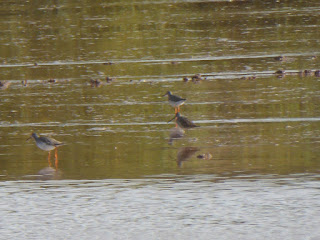It was off to Heathrow Airport by train on Tuesday 24th September for our flight to Palermo in Sicily and the start of our museums and ancient ruins holiday
We began our trip in Palermo with a few days sight seeing, staying in the NH Palermo hotel near the old city and opposite the botanical gardens and with a room overlooking the port and the sea. Palermo was great, very hot and sunny with some beautiful architecture, an amazing archeological museum that is unfortunately only partially open at the moment, a relaxed air and some great food.
Palermo
Palermo
Palermo
Palermo
Palermo
Birding was slow as expected in a busy city but I did see some familiar birds - blackbird, woodpigeon, collared dove, swallow, grey wagtail, goldfinch, great tit, kestrel, ring-necked parakeet, swift, blackcap and feral pigeon - plus a few less familiar ones - yellow-legged gull, hooded crow, Sardinian warbler, spotless starling and tree sparrow.
Butterflies and moths were also seen and I managed to get some good views of hummingbird hawkmoths and vestals plus clouded yellow, geranium bronze, painted lady, Lang's short-tailed blue, red admiral and small white.
Vestal
Geranium Bronze
Lang's Short-tailed Blue
Painted Lady
Wall lizards (Sicillian/Italian) were noted too in the botanical gardens along with violet dropwings, a demoiselle species, a large dragonfly species (emperor?) and a few small red dragonfly species.
Dragonfly Sp.
Violet Dropwing
We ventured out of Palermo on Thursday 26th September and caught a train to the ancient city of Solnus, a short 20 minute journey away along the coast and where we spent a few happy hours wandering around in the baking heat while admiring the ruins, views and wildlife.
Solnus
A very skittish juvenile Eastern black-eared wheatear was the highlight as it fed around the ruins and I also saw 2 ravens, magpie and linnet while offshore a flock of small gulls were resting on the sea before being buzzed by yellow-legged gulls and flying off but too far out to properly ID.
Eastern Black-eared Wheatear
Swallowtails were very noticeable around the site but were very difficult to photograph in the heat and I also found a small heath, clouded yellow, a scarce swallowtail, a Cleopatra, painted lady, a small skipper species (Mediterranean/ pygmy?) small white and dragonflys. Wall lizards were everywhere and I also found a few very nervous Moorish geckos that scuttled off before I got anywhere near them.
Swallowtail
Mediterranean/Pygmy Skipper
Wall Lizard
Dragonfly Sp.
Dragonfly Sp.
Flower Sp. in the ruins
Saturday 28th September and it was time to leave Palermo and head off on the train to Agrigento, a 2 hour journey away. The views from the train were stunning and I added grey heron, great white egret, jackdaw and crested lark to the bird list along the way.
On arrival in Agrigento we picked up our hire car for the week and drove to the nearby Villa San Marco, our base for the next 3 days and an absolute delight set in quiet solitude right in the Valley of The Temples and with amazing views across the countryside. It was a great place to stay with a fantastic breakfast on the terrace each morning, a menagerie of birds and animals, a small swimming pool and a great view of the temples including from our room terrace where we enjoyed a glass of Sicillian wine at night listening to calling stone curlews and Scops owls while bats flitted about over the trees.
The Valley of The Temples archeological site covered a huge area and with the baking heat it was great that we had the time to take things slowly and explore the ruins at leisure over the 3 days.
Valley of The Temples
Valley of The Temples
Being more rural the birding was more varied and I added some good birds to my trip list. A fly away hoopoe and 2 bee eaters flying overhead were all too brief but 2 blue rock thrush in the ruins were more confiding. Serins were regularly seen flying around and buzzards soared overhead on the thermals along with a juvenile Egyptian vulture and a booted eagle. Crag martin, house martin, Italian sparrow, mallard, moorhen, blue tit and spotted flycatcher were also seen with Cettis warblers and Sardinian warblers also heard.
Egyptian Vulture
Booted Eagle
Booted Eagle
Butterflies were also noticeable with swallowtail, scarce swallowtail, Cleopatra, wall, Langs short-tailed blue, clouded yellow and small white seen. Wall lizards were everywhere and I also found a Turkish gecko on the wall at our Villa.
Scarce Swallowtail
Scarce Swallowtail
Wall
Lang's Short-tailed Blue
Dragonfly Sp.
Turkish Gecko
It was soon time to continue our tour of the island and so Tuesday 1st October saw us driving onwards to Selinunte via the ruins at Eraclea Minoa for the next part of our holiday.








































































